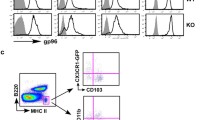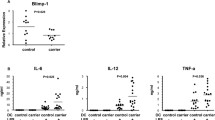Abstract
The multifunctional pattern recognition scavenger receptors, SR-A and CD36, are predominantly expressed by lamina propria macrophages and considered important in innate immunity. We examined the role of these receptors in the pathophysiology of inflammatory bowel disease. Colitis was induced in wild type (WT), SR-A−/−, CD36−/−, and SR-A/CD36 double deficient mice by administering DSS. DSS-induced moderately severe colitis in WT mice was manifested by weight loss, reduced hematocrit, and pathology. SR-A/CD36 double deficient mice developed significantly more severe colitis as indicated by anemia (P < 0.01), decreased colonic length due to inflammation (P < 0.01), and lesions when compared with WT and single deficient animals. Serum amyloid A was significantly more elevated in SR-A/CD36−/− mice (P < 0.01) compared with WT and single deficient animals. However, the spleens of WT mice (P < 0.05) were significantly enlarged. Inflammatory cytokine levels were considerably increased in WT mice (IL-6 P < 0.001, TNFα P < 0.01). In contrast, SR-A deficient mice maintained more normal body and splenic weight and developed less severe colonic lesions compared to other groups. In conclusion, our data indicate that SR-A/CD36 double deficiency leads to more severe colonic lesions and dysregulated inflammatory response as compared with single SR-A or CD36 deficiency in colitis, suggesting additive effects between these two receptors in this model.






Similar content being viewed by others
Abbreviations
- DSS:
-
Dextran sodium sulphate
- INF-γ:
-
Interferon gamma
- IL-6:
-
Interleukin-6
- LDL:
-
Low-density lipoprotein
- LPS:
-
Lipopolysaccharide
- LTA:
-
Lipoteichoic acid
- MФ:
-
Macrophage
- SR-A:
-
Scavenger receptor A
- TNFα:
-
Tumor necrosis factor
- WT:
-
Wildtype
References
Gordon S. The macrophage scavenger receptor type A is expressed by activated macrophages and protects the host against lethal endotoxic shock. J Exp Med. 1997;186:1431–1439. doi:10.1084/jem.186.9.1431.
Gordon S. Pattern recognition receptors: doubling up for the innate immune response. Cell. 2002;111:927–930. doi:10.1016/S0092-8674(02)01201-1.
Platt N, Gordon S. Is the class A macrophage scavenger receptor (SR-A) multifunctional?—The mouse’s tale. J Clin Invest. 2001;108:649–654.
Geng YJ, Hansson GK. Interferon-gamma inhibits scavenger receptor expression and foam cell formation in human monocyte-derived macrophages. J Clin Invest. 1992;89:1322–1330. doi:10.1172/JCI115718.
Hsu HY, Nicholson AC, Hajjar DP. Inhibition of macrophage scavenger receptor activity by tumor necrosis factor-alpha is transcriptionally and post-transcriptionally regulated. J Biol Chem. 1996;271:7767–7773. doi:10.1074/jbc.271.13.7767.
De Villiers WJS, Fraser IP, Hughes DA, Doyle AG, Gordon S. Macrophage-colony-stimulating factor selectively enhances macrophage scavenger receptor expression and function. J Exp Med. 1994;180:705–709. doi:10.1084/jem.180.2.705.
De Villiers WJS, Fraser IP, Gordon S. Cytokine and growth factor regulation of macrophage scavenger receptor expression and function. Immunol Lett. 1994;43:73–79. doi:10.1016/0165-2478(94)00148-0.
Guidez F, Li AC, Horvai A, Welch JS, Glass CK. Differential utilization of Ras signaling pathways by macrophage colony-stimulating factor (CSF) and granulocyte-macrophage CSF receptors during macrophage differentiation. Mol Cell Biol. 1998;18:3851–3861.
Ricote M, Li AC, Willson TM, Kelly CJ, Glass CK. The peroxisome proliferator-activated receptor-gamma is a negative regulator of macrophage activation. Nature. 1998;391:79–82. doi:10.1038/34178.
Febbraio M, Hajjar DP, Silverstein RL. CD36: a class B scavenger receptor involved in angiogenesis, atherosclerosis, inflammation, and lipid metabolism. J Clin Invest. 2001;108:785–791.
Ockenhouse CF, Chulay JD. Plasmodium falciparum sequestration: OKM5 antigen (CD36) mediates cytoadherence of parasitized erythrocytes to a myelomonocytic cell line. J Infect Dis. 1988;157:584–588.
Oquendo P, Hundt E, Lawler J, Seed B. CD36 directly mediates cytoadherence of Plasmodium falciparum parasitized erythrocytes. Cell. 1989;58:95–101. doi:10.1016/0092-8674(89)90406-6.
Endemann G, Stanton LW, Madden KS, Bryant CM, White RT, Protter AA. CD36 is a receptor for oxidized low density lipoprotein. J Biol Chem. 1993;268:11811–11816.
Moore KJ, El Khoury J, Medeiros LA, et al. CD36-initiated signaling cascade mediates inflammatory effects of beta-amyloid. J Biol Chem. 2002;277:47373–47379. doi:10.1074/jbc.M208788200.
Medeiros LA, Khan T, El Khoury JB, et al. Fibrillar amyloid protein present in atheroma activates CD36 signal transduction. J Biol Chem. 2004;279:10643–10648. doi:10.1074/jbc.M311735200.
Zhong J, Eckhart E, Oz HS, Bruemmer D, de Villiers W. Osteopontin deficiency protects mice from DSS-induced colitis. Inflamm Bowel Dis. 2006;12:790–796. doi:10.1097/00054725-200608000-00015.
Van Lenten BJ, Fogelman AM. Lipopolysaccharide-induced inhibition of scavenger receptor expression in human monocyte–macrophages is mediated through tumor necrosis factor-alpha. J Immunol. 1992;148:112–116.
Areschoug T, Waldemarsson J, Gordon S. Evasion of macrophage scavenger receptor A-mediated recognition by pathogenic streptococci. Eur J Immunol. 2008;38:3068–3079.
Suzuki H, Kurihara Y, Takeya M, Kamada N, Kodama T, et al. A role for macrophage scavenger receptors in atherosclerosis and susceptibility to infection. Nature. 1997;386:292–296. doi:10.1038/386292a0.
Thomas CA, Li Y, Kodama T, Suzuki H, Silverstein SC, El Khoury J. Protection from lethal gram-positive infection by macrophage scavenger receptor-dependent phagocytosis. J Exp Med. 2000;191:147–156.
Haworth R, Platt N, Keshav S, et al. The macrophage scavenger receptor type A is expressed by activated macrophages and protects the host against lethal endotoxic shock. J Exp Med. 1997;186:1431–1439.
Kobayashi Y, Miyaji C, Watanabe H, et al. Role of macrophage scavenger receptor in endotoxin shock. J Pathol. 2000;192:263–272.
Hagiwara S, Takeya M, Suzuki H, et al. Role of macrophage scavenger receptors in hepatic granuloma formation in mice. Am J Pathol. 1999;154:705–720.
Singh U, Devaraj S, Jialal I. Vitamin E, oxidative stress, and inflammation. Annu Rev Nutr. 2005;25:151–174.
Takeda N, Manabe I, Shindo T, et al. Synthetic retinoid Am80 reduces scavenger receptor expression and atherosclerosis in mice by inhibiting IL-6. Arterioscler Thromb Vasc Biol. 2006;26:1177–1183.
Mytar B, Woloszyn M, Macura-Biegun A, et al. Involvement of pattern recognition receptors in the induction of cytokines and reactive oxygen intermediates production by human monocytes/macrophages stimulated with tumour cells. Anticancer Res. 2004;24:2287–2293.
Li WX, Howard RJ, Leung LL. Identification of SVTCG in thrombospondin as the conformation-dependent, high affinity binding site for its receptor, CD36. J Biol Chem. 1993;268:16179–16184.
Fadok VA, Warner ML, Bratton DL, Henson PM. CD36 is required for phagocytosis of apoptotic cells by human macrophages that use either a phosphatidylserine receptor or the vitronectin receptor (alpha vs. beta 3). J Immunol. 1998;161:6250–6257.
Stolzing A, Grune T. Neuronal apoptotic bodies: phagocytosis and degradation by primary microglial cells. FASEB J. 2004;18:743–745.
Ren Y, Silverstein RL, Allen J, Savill J. CD36 gene transfer confers capacity for phagocytosis of cells undergoing apoptosis. J Exp Med. 1995;181:1857–1862.
Acknowledgment
This study was partially supported by the National Institutes of Health grant NCCAM-AT1490 and NCRR P20RR020145,COHR-Pilot Project (H. S. Oz).
Author information
Authors and Affiliations
Corresponding author
Additional information
H. S. Oz and J. Zhong contributed equally to this work.
Rights and permissions
About this article
Cite this article
Oz, H.S., Zhong, J. & de Villiers, W.J.S. Pattern Recognition Scavenger Receptors, SR-A and CD36, Have an Additive Role in the Development of Colitis in Mice. Dig Dis Sci 54, 2561–2567 (2009). https://doi.org/10.1007/s10620-008-0673-4
Received:
Accepted:
Published:
Issue Date:
DOI: https://doi.org/10.1007/s10620-008-0673-4




